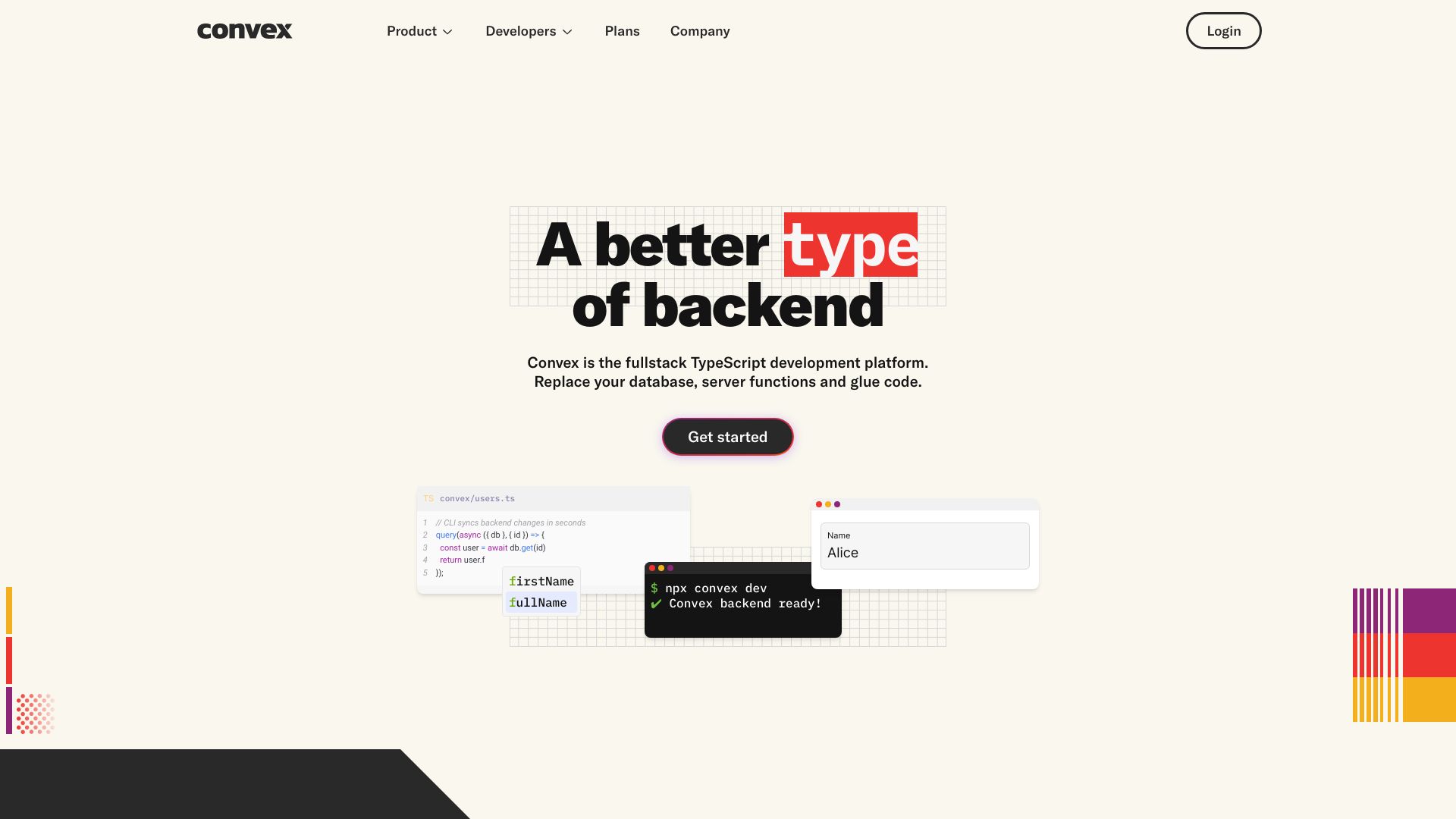- Home
- AI Code Assistant
- Convex

Convex
Open Website-
Tool Introduction:Full-stack TypeScript platform with realtime DB, auth, AI assist, self-host.
-
Inclusion Date:Oct 21, 2025
-
Social Media & Email:
Tool Information
What is Convex AI
Convex AI is a full-stack TypeScript development platform for building reactive applications with a realtime database and managed backend infrastructure. It combines strongly consistent data, reactive queries, and serverless functions with built-in support for authentication and file storage. Developers can ship faster without provisioning servers, sockets, or ORMs. Convex integrates smoothly with frameworks like Next.js and React, offers an open-source self-hosting option, and includes an AI coding assistant that scaffolds code, suggests schema changes, and guides best practices via CLI and editor workflows.
Convex AI Features
- Realtime database with reactive queries: Automatically sync UI state as data changes, eliminating manual polling or custom websockets.
- Serverless functions: Write TypeScript mutations, queries, and actions for business logic without managing infrastructure.
- Strong consistency: Ensure predictable reads and writes for collaborative and transactional use cases.
- Authentication integrations: Plug in common identity providers and libraries to protect routes and data access.
- Open-source self-hosting: Run Convex yourself when you need full control or on-premise deployment.
- AI coding assistant: Generate boilerplate, refine schema and indexes, and get inline guidance to accelerate development.
- Tight framework support: First-class TypeScript SDKs and adapters for Next.js, React, and other modern stacks.
- File storage and scheduling: Store files and schedule background tasks alongside your functions.
Who is Convex AI for
Convex AI suits product teams and solo developers building realtime apps—collaboration tools, chat, dashboards, marketplaces, and SaaS back offices—who want end-to-end TypeScript, rapid iteration, and fewer moving parts. It also fits startups seeking a managed backend with the option to self-host later, and teams standardizing on Next.js or React looking for a consistent data layer and predictable real-time behavior.
How to use Convex AI
- Initialize your project with the Convex CLI and install the TypeScript SDK in your app.
- Define your schema and indexes to model entities and access patterns.
- Create queries, mutations, and actions to implement domain logic on the server.
- Integrate authentication to secure endpoints and enforce access control.
- Connect the client SDK in your React or Next.js components to subscribe to reactive queries.
- Use the AI assistant to scaffold functions, refine types, and optimize indexes.
- Test locally, then deploy to the hosted service or your self-hosted environment.
- Monitor logs and performance, iterate on schema and functions as your app evolves.
Convex AI Industry Examples
A collaborative whiteboard uses Convex’s reactive queries to broadcast shape updates to all participants instantly. A customer support chat routes messages through serverless functions while ensuring consistent message ordering. A marketplace admin panel streams order changes in real time and enforces role-based access with integrated authentication. A SaaS analytics dashboard renders live KPIs from mutations that ingest events and queries that hydrate charts without manual refresh.
Convex AI Pricing
Convex typically provides a free tier suitable for development and small projects, with paid plans for higher usage and production workloads. Teams that require full control can opt for the open-source self-hosting model instead of the managed cloud. Details vary over time; check the official pricing page for current limits and plan features.
Convex AI Pros and Cons
Pros:
- End-to-end TypeScript with a consistent developer experience.
- Realtime data and reactive queries without custom socket code.
- Managed backend and serverless functions reduce operational overhead.
- Integrated authentication, storage, and scheduling out of the box.
- Open-source self-hosting for control and portability.
- AI coding assistant speeds up scaffolding and best-practice adoption.
Cons:
- Requires learning Convex’s data model, indexing, and function patterns.
- Tight integration may increase coupling to platform APIs and tooling.
- Long-running or highly specialized workloads may need external services.
- Migration from existing databases can require refactoring to reactive patterns.
Convex AI FAQs
-
Is Convex a database or a backend platform?
Convex provides both: a realtime, strongly consistent data layer and serverless functions that form a managed backend for your app.
-
Can I self-host Convex?
Yes. An open-source self-hosting option lets you run Convex in your own environment when you need more control.
-
How do reactive queries work?
Clients subscribe to queries; when underlying data changes, Convex pushes updates to keep UI state in sync without polling.
-
Which frameworks are supported?
Convex integrates well with modern TypeScript stacks, including Next.js and React, and can be used with other frameworks via its SDKs.
-
What does the AI assistant do?
It helps scaffold code, propose schema and index changes, and suggest improvements directly in your CLI or editor workflow.

